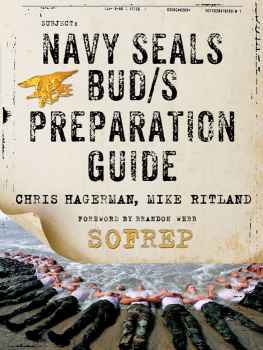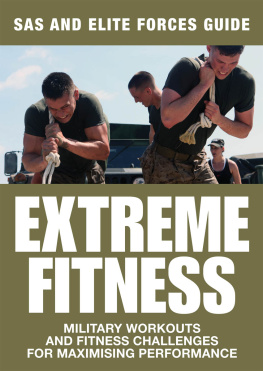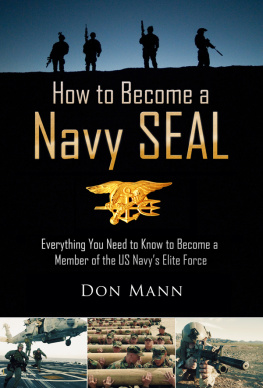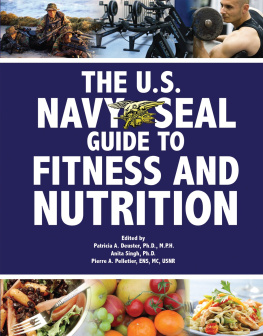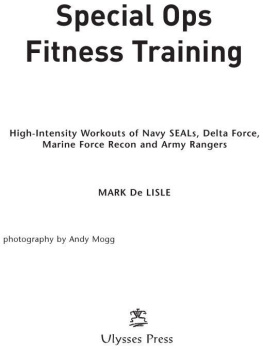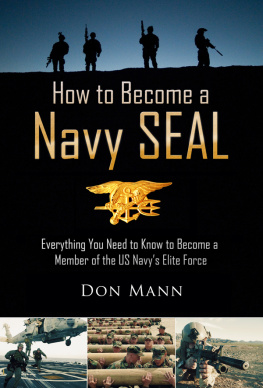Table of Contents
Copyright 2007 by Skyhorse Publishing, Inc.
All Rights Reserved. No part of this book may be reproduced in any manner without the express written consent of the publisher, except in the case of brief excerpts in critical reviews or articles. All inquiries should be addressed to: Skyhorse Publishing, 555 Eighth Avenue, Suite 903, New York, NY 10018.
www.skyhorsepublishing.com
10987654321
Library of Congress Cataloging-in-Publication Data
Deuster, Patricia A.
The Navy SEAL guide to fitness and nutrition Patricia A. Deuster, Anitafont>
Singh, Pierre A. Pelletier.
p. cm.
Originally published as 2 books: Navy SEAL fitness guide. [Bethesda, Md] : Department of Military and Emergency Medicine, 1994 ; and The Navy SEAL nutrition. [Bethesda, Md] : Department of Military and Emergency Medicine, 1994.
ISBN-13: 978-1-60239-030-0 (pbk. : alk. paper)
ISBN-10: 1-60239-030-4 (pbk. : alk. paper)
1. United States. Navy. SEALs. 2. Physical fitness. 3. Exercise. 4.
Nutrition. I. Singh, Anita. II. Pelletier, Pierre A. III. Title.
GV481.D43 2007
613.7dc22
2007005547
Printed in the United States of America
Part I
Physical Fitness
Edited by Patricia A. Deuster, Ph.D., M.P.H.
Acknowledgments
The authors would like to recognize the invaluable contributions to the development of this guide by the following individuals. CAPT Kenneth Long participated in both panel reviews and provided useful suggestions and comments. His meticulous work was greatly appreciated by all. CAPT Peter Toennies reviewed and provided substantive comments about the chapter Swimming for Fitness. Mr. Jeremy Levine and Ms. Brandi Schoeber provided information about strength training.
Importantly, we were extremely fortunate to receive valuable input from several SEALs throughout the development of this guide. ENS Frances Franky and BM1 George Vernia participated in the first panel review and their suggestions were incorporated in the second draft of the manual. BM1 Vernia helped organize and participated in the second and final panel review. Other SEAL panel reviewers included CW03 John Shellnut, Master Chief Bob Bender, LCDR Pat Butler, and BMCS Duane Noel. Each one of these SEALs provided suggestions and practical recommendations which were instrumental in the finalization of the The Navy SEAL Physical Fitness Guide.
About the Authors
Part I: The Navy SEAL Physical Fitness Guide
CAPT Frank K. Butler, Jr., M.D., developed the chapter SEAL Mission-Related Activities. He is currently the Biomedical Research Director for the Naval Special Warfare Command, Chairman of the U.S. Special Operations Command Biomedical Initiatives Steering Committee, and a Staff Ophthalmologist at the Naval Hospital, Pensacola, Florida. He obtained his undergraduate degree from Georgia Institute of Technology in 1971, with high honors. His medical degree is from Medical College of Georgia, 1980. Dr. Butlers Family Practice Internship was at the Navy Regional Medical Center, Jacksonville, Florida (1980-1981) and his Ophthalmology Residency was at the National Naval Medical Center, Bethesda, MD. where he was Chief Resident (1988-1989). He completed his Undersea Medical Officer Training from the Undersea Medical Institute, Groton, Ct., 1981. CAPT Butler has been a platoon Commander for Underwater Demolition Team TWELVE and SEAL Team ONE, and a Diving Medical Research Officer at the Navy Experimental Diving Unit. He has published extensively and been a frequent guest lecturer on the subject of closed-circuit diving and Special Warfare.
CAPT John S. Hughes, M.D., developed the chapter Swimming for Fitness and contributed to Other TrainingRelated Issues. He is a Navy Reserve Undersea Medical Officer who resides near Littleton, Colorado. A graduate of the University of Colorado School of Medicine, Dr. Hughes has a Naval Reserve assignment to NAVSEA in Crystal City, Virginia, where he is assigned to the Supervisor of Diving and Salvage. Dr. Hughes has been involved with Navy diving medicine since 1981. He is Board Certified in Occupational Medicine and his civilian medical practice in Colorado and Wyoming involves operation of clinics and health facilities covering a wide range of high risk industries including commercial diving.
Special qualifications allow Dr. Hughes to participate in the development of the Navy SEAL Physical Fitness Guide. He swam freestyle in the NCAA Championships and won the 1976 Big 8 Conference Championship in the 1650 yd freestyle for the University of Colorado and has remained active as a competitive swimmer. As a mountaineer and cross country skier he has organized and participated in numerous climbs, including two on Denali and Denali North Peak in Alaska. His instrumental work with the SEAL team in developing a winter warfare program during 1982 led him to participate as a staff member of the SEAL winter warfare Greenland operation in 1983. For this involvement, Dr. Hughes received a letter of appreciation from the CO of SEAL Team TWO, CDR Rick Woolard. With the theme of Dr. Hughes career being medical support of high risk military and industrial operations, he feels that work for the SEALs is at the head of the list.
CDR Joseph Moore, M.D., developed the chapter Training and Sports-Related Injuries. He completed his undergraduate degree in 1978, and medical degree in 1982 from the University of Virginia after which he was commissioned as a Lieutenant in the Naval Medical Corps. CDR Moore completed his internship at Naval Medical Center, Oakland, California, in June 1983, and received orders to the 1st Marine Division, Camp Pendleton, California. He served as Battalion Surgeon, 2nd Battalion, 9th Marines from July 1983 to October 1985, deploying to Okinawa, Korea and Panama. He also served as 5th Marines Regimental Surgeon during this time period. He completed a Family Practice residency at the Naval Hospital, Camp Pendleton in 1987, followed by a tour as Senior Medical Officer on the island of La Maddalena, Italy. CDR Moore was the first Navy physician selected for a primary care Sports Medicine fellowship, and trained at the San Diego Sports Medicine Center and San Diego State University from December 1989 through January 1991.
CDR Moore is currently the Department Head and Fellowship Director for the Navys Sports Medicine program at the Naval Hospital and Marine Corps Base, Camp Pendleton. In addition to his duties as Specialty Leader to the Surgeon General, Dr. Moore serves as chairman of the Sports Medicine Advisory Panel to the U.S. Naval Special Warfare Command, Coronado, and advisor to Marine Corps Combat Development Command, Quantico. His work with the civilian community has earned him an appointment by the Governor of California to the Governors Council on Physical Fitness and Sports. He also holds an appointment to the United States Olympic Committee Team Physician Development Program, Colorado Springs, CO. He is co-chairman of the American Academy of Family Physicians Review Course for Sports Medicine.
CDR Brad L. Bennett, Ph.D., developed the Chapter Load Bearing and he has written a technical report Load Carriage: Are You Preparing Correctly? Naval Medical Research Institute, Technical Memo 96-71, 1991. He is a research physiologist currently assigned to the
Department of Military and Emergency Medicine, School of Medicine, Uniformed Services University of the Health Sciences, Bethesda, MD. He serves as an Assistant Professor and Director of the Basic Sciences Division. He is a graduate of Wilderness Medicine, and Tactical Emergency Medical Technician courses, and is a department faculty member in the Counter Narcotics Tactical Operations Medical Support (CONTOMS) course as sponsored by the Department of Defense. He earned a Bachelor and Master Degrees in Exercise Science from San Diego State University and a Ph.D. in Kinesiology from the University of Maryland.



